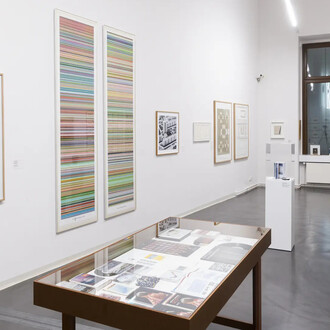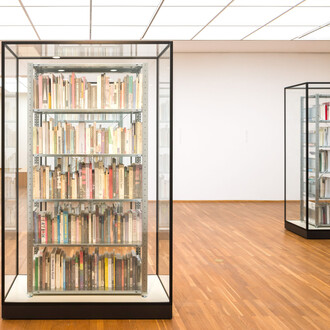In the 1990s a new art scene began to form in Cologne. New galleries, magazines such as Texte zur Kunst, and the alternative exhibition space Friesenwall 120 were started. Alexander Schröder followed these developments from Berlin. Already as an art student at the Hochschule der Künste Berlin, he founded his own gallery along with Thilo Wermke. At the same time, he began collecting art from the 1990s and 2000s with his special eye.
Today his collection exemplifies the idiosyncratic and sensual side of this era, which was shaped by Conceptual Art. It demonstrates the significance of artist groups and collaborations in changing constellations at the time. Proximity and distance, connections and competition, inclusion and exclusion existed in productive friction with each other. Now the Schröder family has donated twenty-nine works from their collection, including large-scale installations, to the Museum Ludwig by artists such as Kai Althoff, Cosima von Bonin, Tom Burr, Lukas Duwenhögger, Isa Genzken, and Danh Võ. The exhibition Family Ties: The Schröder Donation presents these works to the public along with a selection from the Museum Ludwig collection. It focuses on art at the turn of the twenty-first century and examines the special conditions that existed in Cologne, also in relationship to New York.
Director Yilmaz Dziewior: “I am delighted that with this donation, numerous works that were originally closely linked to Cologne or first exhibited here are now permanently back in their place of origin.”
Around 1995, the field of art expanded. Proclaimed art movements and schools were replaced with group affiliations. Family-like structures or networks shaped working methods and thus also aesthetic decisions. In her work, Cosima von Bonin equates friends and role models with family ties. By contrast, Kai Althoff translates ambivalent group dynamics into powerful works that deal with the longing or compulsion associated with belonging to a group. Artists entered into collaborations that were less based on the works themselves than on the process.
They include Andrea Fraser, Renée Green, Christian Philipp Müller, and Nils Norman. Their working methods sometimes differed: the self-proclaimed bohemian, the (temporary) collective, and the temporary network in constant flux based on specific questions with an open exchange were three possible models. The writings of the sociologist Pierre Bourdieu were an important reference point for these artists who engaged with Institutional Critique. Bourdieu describes the relationship to role models as a “strategy of belonging,” among other things. Renée Green prefers to speak of contact zones. She uses them to outline genealogies that, in contrast to previous traditions, do not refer to a linear history or origin, but instead portray history as present and fragmentary. Lukas Duwenhögger has a similar approach: his own histories of self-selected references replace the biological understanding of family. The concept of family ties is evident in a variety of ways in the featured artworks from the 1990s and early 2000s. The social becomes material for art.
















